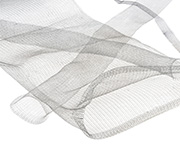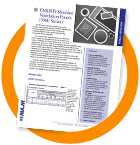In simple terms, radiated EMI emission starts from an emitting source, propagates via a radiating path and reaches a susceptible receiver. The strength of the radiated EMI is determined by the source, the media surrounding the source and the distance between the source and the susceptor1…unless there are cables in close proximity to the source or receptor, in which case all bets are off. In that case you need EMI shielding tape.
Electronic or electrical cables can compound EMI noise problems as they are major transmitter of stray signals. Unshielded cables can act as a conductor, sending direct disruption to sensitive equipment. They can also act like an antenna, spreading RF noise throughout a hardened enclosure. But they also act like a receptor, picking up stray EMI from other places. The best way to keep those signals contained along cabling is with EMI shielding tape.
 EMI shielding tape is a knitted circular strip of wire mesh that resembles a gauze tube or elongated wire stocking. It’s construction is perfect for wrapping cables where conformity is needed without adding a lot of weight or bulk. It’s flexibility characteristics make it more suitable than foil tape where cables twist or bend. Using the appropriate diameter EMI shielding tape to fit the application, cables are covered in an over-wrap fashion to avoid gaps and achieve attenuation. The wrap can then be grounded at one or both ends.
EMI shielding tape is a knitted circular strip of wire mesh that resembles a gauze tube or elongated wire stocking. It’s construction is perfect for wrapping cables where conformity is needed without adding a lot of weight or bulk. It’s flexibility characteristics make it more suitable than foil tape where cables twist or bend. Using the appropriate diameter EMI shielding tape to fit the application, cables are covered in an over-wrap fashion to avoid gaps and achieve attenuation. The wrap can then be grounded at one or both ends.
Besides coming in various diameters ranging from .437” to 5.5” to form numerous possible widths for the wrap, MAJR Products offers knitted wire mesh tape in variety of metal wires. Our Sn/Cu/Fe wire, in accordance with ASTM B-520, provides 3% tin for low impedance and maximum corrosion resistance, 40% copper for maximum conductivity and 54% steel for strength and permeability. It offers superior performance characteristics in terms of pull strength (50 lbs) and elongation (100 percent). RFI/EMI shielding tape is also available in monel and aluminum wires, allowing you to choose the right material for your application without needlessly over-spending. Very few of our competitors can offer so many choices in terms of tape diameter and the material used.
Don’t let those electrical or electronic cables and harnesses become a raceway for EMI noise or an antenna for picking up and broadcasting stray signals. Overbraiding with EMI shielding mesh tape is the easiest and most cost effective way to achieve the attenuation needed for a hardened enclosure.
You can find more technical details and a spec download on a page devoted to knitted wire mesh tape on our website, where you can request free samples. You can also call or message our our engineers if you have questions about metal wire choices, proper diameters or the required overlap for your application.
1Xingcun Colin Tong, Advanced Materials and Design for EMI Shielding, CRC Press, Taylor and Francis Group, 2009. Chapter 1.1.2.2 “Radiated EMI Emission”, pg. 6.


